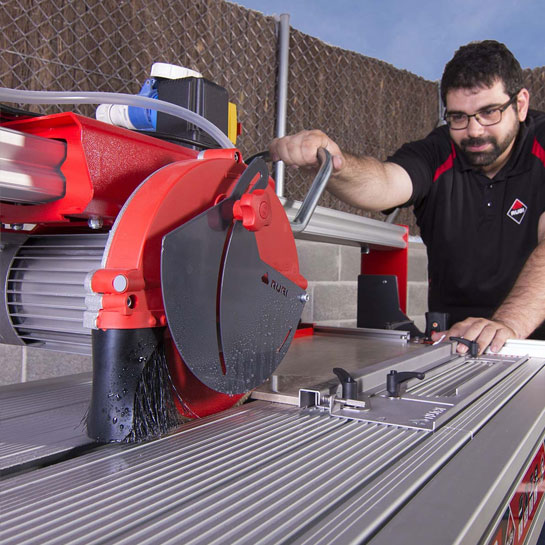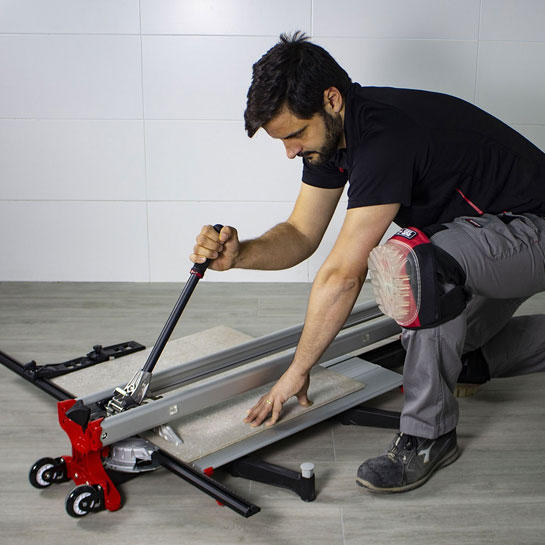Choosing between electric and manual tile cutters is complex. Facing the purchase of this tool is an important step in the world of renovations.
These devices are essential for working with tiles and other similar materials, but in the market you will find a large number of brands with multiple models. In this article, we are going to help you solve one of the most frequent doubts: manual or electric?
Electric tile cutters
Let’s start by talking about the models of electric tile cutter. For their use, no physical effort is required and they are able to cope with pieces of great hardness and thickness. To do this, they incorporate an electric motor that is responsible for giving life and strength to a diamond disc, available in different sizes and compositions.

The head, in which this piece is placed, is capable of facing various cuts, such as bevel cuts, square holes, grooves or miters among others. The precision and finish they offer is of high quality and they can work with any material, including natural stone.
For this machine to work , it is necessary to connect it to the power supply, although there are models with batteries. Likewise, the degree of maintenance and cleaning required is quite high. However, the speed and ease with which they perform their function is undeniable.
Advantages of electric tile cutters
These are the main advantages of electrically powered cutters:
- Low percentage of breakage of pieces in the cuts.
- Great finish.
- Capable of dealing with complex cuts.
- Wide variety of cuts.
- Safe, comfortable and easy to use.
Advantages of electric tile cutters
On the contrary, they have a number of drawbacks that you should also be aware of:
- They are equipped with an electric motor which, in case of failure, renders them inoperative.
- Their dimensions and volume make them heavier and more complex to transport or store.
- Some models need water to work.
Manual tile cutters
Now it is time to get to know the features offered by manual cutters. This tool is very simple to assemble and use, but it requires physical strength for its operation. With a little effort you will achieve a great result when working with tiles and other similar materials.

A myriad of models are available on the market. The differences between them can be summed up in two key features that you cannot overlook:
- Accepted dimensions: They mark the maximum size of the tile they are capable of coping with.
- Power: They delimit the hardness of the material that accepts its drive mechanism in combination with the blade.
Despite these factors that separate each of the models, there are other peculiarities that are common to all of them. These tools are very light and practical. In addition, they do not require complex maintenance, beyond removing material residues after use and greasing them from time to time.
Advantages of manual tile cutters
These are the main advantages you will enjoy when using a manual model:
- They are easy to store and transport thanks to their size and light weight.
- They do not require electric current or water for their operation.
- When cutting, they do not create dust, which generates a cleaner working space.
- They can be used anywhere.
Disadvantages of manual tile cutters
Of course, it also has some disadvantages:
- They do not have such a wide variety of cuts.
- They do not accept very thick or hard materials.
- They require greater skill to avoid breakage of the parts.
How to choose tile cutters
Now you know the main features of both electric and manual tile cutters. Now it is time to pay attention to the main points you need to pay attention to in order to choose one option or the other.
The main differences between the two models
A comparison of the two tools reveals a number of details that distinguish them directly:
- Accepted materials: Manual models are more limited in terms of thickness and type of material accepted than electric models.
- Maintenance: The electric motor and mechanism need more complex and thorough cleaning to prevent breakdowns.
- Noise: The manual ones do not emit sound when carrying out the work. The motor of the electric ones causes ambient noise.
- Space: Dimensions are the main difference between the two. This affects both transportation and storage.
- Price: Electric models require a much higher investment than manual models.
- Type of cut: The manual option only accepts straight or angular cuts suitable for perimeter work.
Determining factors for choosing a tile cutter
To help you choose, we are going to provide you with a series of keys that will help you in the process. These are the main factors that determine the choice of one model over another:
- Its use: Consider the work you are going to do with it. It is not the same to carry out a small project than to face a work of great dimensions.
- Budget: Spending capacity will determine the alternatives from which you can choose.
When it comes to selecting this type of tool, there is no single answer. However, if you are making your first purchase, manual models are the preferred choice because of their lower investment. They are also capable of carrying out basic work without difficulty.
If you have any doubts about how to use the tile cutting machine, here you have some help
In those cases where a more professional use is required, electric models are used. It is important to emphasize that having a cutter of each type provides a unique versatility and makes it possible to adapt to all kinds of challenges and jobs with ease.
Selecting one among the different electric and manual tile cutters available on the market is easier with this comparison. After analyzing the features and comparing the models, you will make a better choice by purchasing a tool that suits your needs. If you are going to work with tiles and ceramic materials, it is essential that you have a cutter that will help you work smoothly and quickly. Discover the models we have available and find the perfect option for you on our website.


